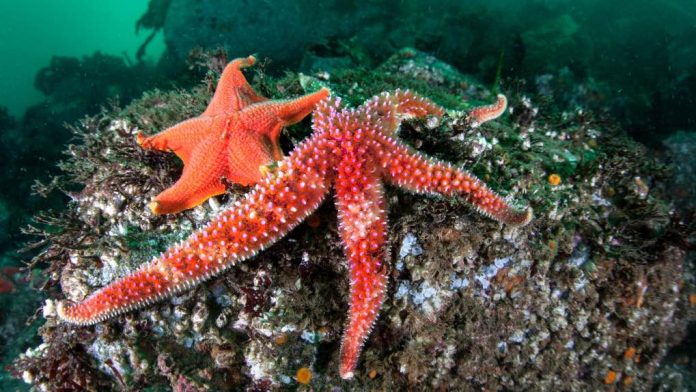For the past four years, a mysterious syndrome has been killing millions of sea stars along the West Coast, turning the five-armed critters into piles of goo. But now, the sea stars appear to be making a comeback, according to news reports.
After the Sea Star Wasting Syndrome affected the invertebrates during 2013-14 from British Columbia to Mexico, the species was recently seen rebounding and was spotted around Southern California, in places such as the rocky outcroppings off Crystal Cove State Beach and the breakwalls in Long Beach and coves of Palos Verdes, the Register said.
When the syndrome hit the starfish, they developed lesions and then disintegrated with their arms turning into blobs of goo, the Star reported. While deaths of starfish in a similar manner were reported in the 1970s, ’80s and ’90s , the magnitude of the recent outbreak was larger and widespread, according to a report by researchers at the University of Santa Cruz’s Ecology and Evolutionary Biology department.
The outbreak, that began with the killing of ochre stars in Washington state, spread to include mottled stars, leather stars, sunflower stars, rainbows and six-armed stars. Southern California came under the epidemic by December 2013.
“When it did (arrive), you just started to see them melt everywhere,” Darryl Deleske, an aquarist for the Cabrillo Marine Aquarium in Los Angeles, told the Register. “You’d see an arm here, an arm there.”
When the disease hit the sea stars and lesions appeared, they would be followed by a decay of tissues surrounding the lesions, which led to eventual fragmentation of the body and death.
The cause of the syndrome remained mysterious and unclear, but was put down as typically a bacterium (vibrio), when pathological studies were done, according to the website of University of California, Santa Cruz. However, the wasting event on the east coast of the U.S. was attributed to a virus.
“I believe it’s a virus, but it’s unknown where it started,” Deleske said.
However, Deleske also added: “They are coming back, big time. It’s a huge difference. A couple of years ago, you wouldn’t find any. I dove all the way as far as Canada, specifically looking for sea stars, and found not a single one.”
Kaitlin Magliano, education coordinator at the Crystal Cove Conservancy, told the Register winter low tides offered a good look at the starfish, which were the size of a hand, emerging recently in local tidepools.
“It’s a treasure we always hope to find,’ she said.
Magliano said she spotted four “huge, adult” stars about 7 to 8 inches long, during an outing in early December, just south the cottages at Crystal Cove State Par. Magliano stated they were the biggest stars she saw since before the wasting syndrome hit.
“Post sea star wasting, we lost all of them,” she said. “It’s good to see we have some surviving and thriving…Maybe the next generation will be more resilient.”
The Register reported according to Deleske and other researchers, traces of the Sea Star Wasting Syndrome remained in nature, and the stars were not completely out of danger.
Researchers at Cabrillo Aquarium began treating some sick stars with antibiotics, leaving others to fight disease naturally in an experiment. The treated stars appeared healthier, the report stated.
“They don’t seem to be dying like they used to,” Deleske said. “We’ve seen some good results.”
































